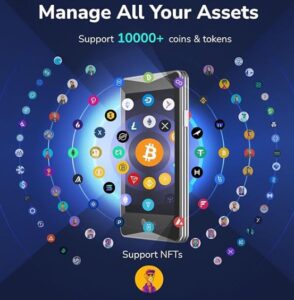The advent of digital currencies, particularly cryptocurrencies, has opened up new avenues for generating passive income. As the popularity and acceptance of cryptocurrencies continue to grow, there are several strategies that investors can use to Generating Passive Income with Digital Currencies. Here’s a guide on how to get started with
Understanding Digital Currencies
Digital currencies, or cryptocurrencies, are decentralized digital assets that use blockchain technology to secure transactions. Bitcoin and Ethereum are the most well-known examples, but there are thousands of other cryptocurrencies available. The decentralized nature of these currencies means they are not controlled by any central authority, making them a unique asset class for investment.
Strategies to produce Passive Income with Digital Currencies
- Staking
- What It Is: Staking involves participating in the proof-of-stake (PoS) mechanism of a blockchain network. By holding and “staking” a certain amount of cryptocurrency, you help maintain the network’s operations and security.
- How It Works: Investors lock up their tokens in a wallet to support blockchain operations. In return, they receive staking rewards, typically in the form of additional tokens.
- Getting Started: Choose a PoS cryptocurrency like Ethereum 2.0, Cardano, or Tezos. Use a staking platform or wallet that supports staking, deposit your tokens, and start earning rewards.
- Yield Farming
- What It Is: Yield farming involves lending or staking your cryptocurrency in decentralized finance (DeFi) protocols to earn interest or rewards.
- How It Works: By providing liquidity to DeFi platforms, you earn returns from transaction fees or interest paid by borrowers. These returns can be quite high but come with higher risks.
- Getting Started: Platforms like Uniswap, Aave, and Compound allow you to deposit your crypto assets into liquidity pools or lending protocols. Monitor the annual percentage yields (APYs) and risks before committing your assets.
- Interest-Earning Accounts
- What It Is: Similar to traditional savings accounts, interest-earning crypto accounts allow you to earn interest on your digital assets.
- How It Works: You deposit your cryptocurrencies into an account offered by platforms like BlockFi, Celsius, or Nexo. These platforms lend your assets to borrowers and pay you a portion of the interest earned.
- Getting Started: Choose a reputable platform, create an account, deposit your cryptocurrencies, and start earning interest. Compare interest rates and terms across platforms to maximize your returns.
- Crypto Dividends
- What It Is: Some cryptocurrencies and tokens pay dividends to holders, similar to traditional stock dividends.
- How It Works: By holding certain tokens, you receive periodic payments or additional tokens. These payments can be in the form of transaction fees distributed among holders or specific dividend tokens.
- Getting Started: Research cryptocurrencies that offer dividends, such as NEO (which pays GAS) or KuCoin Shares (KCS). Purchase and hold these tokens in a compatible wallet to receive dividends.
- Masternodes
- What It Is: Running a masternode involves maintaining a full node of a cryptocurrency network that performs specific functions, such as processing transactions and securing the network.
- How It Works: Masternode operators are compensated with rewards, usually in the form of the network’s cryptocurrency. This requires a significant initial investment and technical knowledge.
- Getting Started: Choose a cryptocurrency that supports masternodes, like Dash or PIVX. Meet the minimum requirements for holding tokens, set up the necessary infrastructure, and begin operating the masternode.
- Crypto Lending
- What It Is: Crypto lending platforms allow you to lend your digital assets to borrowers in exchange for interest payments.
- How It Works: By lending your cryptocurrencies on platforms like Celsius, BlockFi, or Binance, you earn interest over the loan period. The platforms handle the lending process and interest payments.
- Getting Started: Sign up on a crypto lending platform, deposit your cryptocurrencies, choose your lending terms, and start earning interest.
- Liquidity Mining
- What It Is: Liquidity mining involves providing liquidity to decentralized exchanges (DEXs) and earning rewards.
- How It Works: By depositing your cryptocurrencies into liquidity pools on DEXs like Uniswap or SushiSwap, you earn a share of the trading fees and possibly additional tokens.
- Getting Started: Choose a DEX, connect your wallet, select the liquidity pool you want to join, and deposit your tokens. Monitor the returns and risks associated with liquidity mining.
Risks and Considerations with Digital Currencies
- Market Volatility: Cryptocurrencies are known for their price volatility. The value of your holdings can fluctuate significantly, impacting your passive income.
- Platform Risks: DeFi platforms and other crypto services can be vulnerable to hacks, fraud, and technical issues. Ensure you use reputable platforms with strong security measures.
- Regulatory Risks: Cryptocurrency regulations are evolving, and changes in regulations can affect the viability of certain passive income strategies.
- Impermanent Loss: In liquidity mining, the value of your deposited tokens can change relative to each other, leading to potential losses when you withdraw your assets.
- Initial Investment and Knowledge: Some strategies require a significant initial investment and technical understanding. Ensure you have the necessary knowledge and resources before committing.


Conclusion
Generating passive income with digital currency offers exciting opportunities but also comes with risks. By staking, yield farming, lending, running masternodes, and other strategies, you can earn a steady income from your crypto assets. Start by educating yourself, choosing reputable platforms, and understanding the risks involved. With careful planning and management, you can leverage digital currencies to build a reliable passive income stream, contributing to your overall financial security and freedom.
If you would like to know more passive income ideas, you can read other post as 17 Best Passive Ideas or Forbes Best Passive Ideas for 2024.